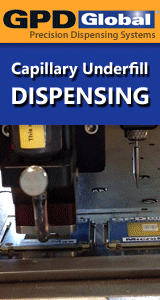Printed Circuit Board Assembly & PCB Design Forum
SMT electronics assembly manufacturing forum.
- SMTnet
- »
- Electronics Forum
- »
- Cleaning SMD Adhesives
Cleaning SMD Adhesives
![]() Is anybody "successfully" cleaning adhesives from the DEK Pu...
- Jul 23, 2002
by
CarlN
Is anybody "successfully" cleaning adhesives from the DEK Pu...
- Jul 23, 2002
by
CarlN
![]()
![]()
![]() Searched the Archives??? Gold star.
You're correct. I d...
- Jul 23, 2002
by
davef
Searched the Archives??? Gold star.
You're correct. I d...
- Jul 23, 2002
by
davef
![]()
![]()
![]() Using ultrasonic technology to remove adhesive is normally n...
- Jul 24, 2002
by
Using ultrasonic technology to remove adhesive is normally n...
- Jul 24, 2002
by
![]()
![]()
![]() Hello,
Understand you have problem of cleaning adhesives ...
- Jul 25, 2002
by
Eric Chua
Hello,
Understand you have problem of cleaning adhesives ...
- Jul 25, 2002
by
Eric Chua
![]()
![]()
![]() Dave,
Are you using The DEK plastic stencils with the 390...
- Jul 29, 2002
by
CarlN
Dave,
Are you using The DEK plastic stencils with the 390...
- Jul 29, 2002
by
CarlN
![]()
![]()
![]() Interesting. From the reaction we got from DEK, I thought we...
- Jul 29, 2002
by
Interesting. From the reaction we got from DEK, I thought we...
- Jul 29, 2002
by
![]()
![]() Hi CarlN,
I�m quite surprised that you viewed my response...
- Aug 02, 2002
by
Hi CarlN,
I�m quite surprised that you viewed my response...
- Aug 02, 2002
by
![]()
![]()
![]() I finally found the answer!
I just got back from visiting...
- Aug 27, 2002
by
CarlN
I finally found the answer!
I just got back from visiting...
- Aug 27, 2002
by
CarlN
![]()
![]()
![]() Hello Carl,
Is the 220-A chemistry from Smart Sonic aqueo...
- Sep 18, 2002
by
kerryn hijacker
Hello Carl,
Is the 220-A chemistry from Smart Sonic aqueo...
- Sep 18, 2002
by
kerryn hijacker
![]()
![]()
![]() Hi ,
DEK S'pore came out with a univeral frame called 've...
- Oct 23, 2002
by
KC
Hi ,
DEK S'pore came out with a univeral frame called 've...
- Oct 23, 2002
by
KC
![]()
![]()
![]() I hope you'll take an answer from the sunny UK. I don't usua...
- Oct 30, 2002
by
Alan Hobby
I hope you'll take an answer from the sunny UK. I don't usua...
- Oct 30, 2002
by
Alan Hobby
![]()
- SMTnet
- »
- Electronics Forum
- »
- Cleaning SMD Adhesives








